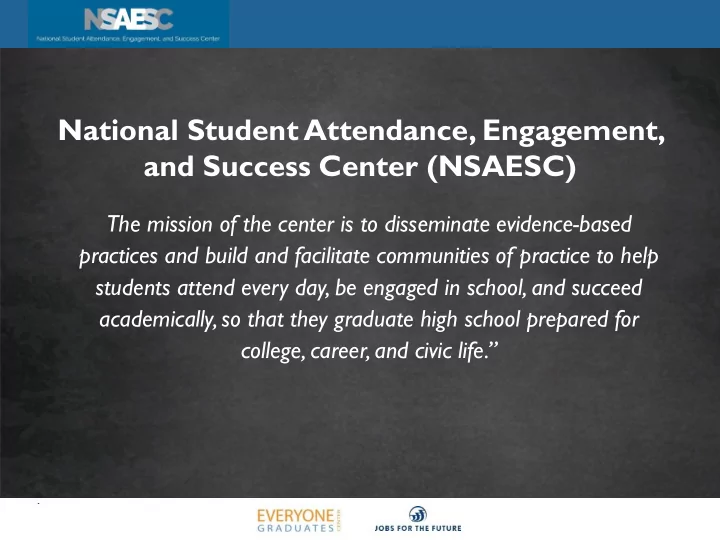

National Student Attendance, Engagement, and Success Center (NSAESC) The mission of the center is to disseminate evidence-based practices and build and facilitate communities of practice to help students attend every day, be engaged in school, and succeed academically, so that they graduate high school prepared for college, career, and civic life.” National Student Attendance, Engagement, and Success Center 1
National Center – Communities of Practice National Student Attendance, Engagement, and Success Center 2
Moving away from Truancy to Chronic Absence Reflects a New Paradigm Truancy Chronic Absence • Counts unexcused • Counts all absences absences • Emphasizes • Emphasizes academic impact compliance with of missed days. school rules • Uses preventive • Uses legal, typically strategies, positive more punitive messaging solutions 3
Chronic absence is missing so much school for any reason that a student is academically What is Chronic Absence? at risk. Attendance Works recommends defining it as missing 10% or more of school for any reason. Chronic Excused Unexcused Suspensions Absence absences absences Chronic absence is different from truancy (unexcused absences only) or average daily attendance (how many students show up to school each day). 4
Student Attendance is Strongly Associated with Academic Success College Completion: Students who attend school regularly in high High School school are more likely Completion: Students to persist in college who attend school and graduate Middle School Success: regularly are more Students who attend likely to graduate from school regularly are high school 3 rd Grade: Students more likely to have who attend school passing grades in regularly are more middle school K-1 st Grade: Students likely to be able to read who attend regularly proficiently by the end in the early grades of 3 rd grade. perform better on measures of academic and social and emotional capacities. 5
Factors That Contribute to Chronic Absence Negative School Lack of Barriers Misconceptions Experiences Engagement • Illness, both chronic • Struggling • Lack of culturally • Absences are only a and acute academically or relevant, engaging problem if they are socially instruction unexcused • Lack of health, mental health, vision, • Bullying • No meaningful • Missing 2 days per or dental care relationships with month doesn’t affect • Suspensions and adults in school learning • Trauma expulsions • Stronger ties with • Sporadic absences • Unsafe path to/from • Negative attitudes of peers out of school aren’t a problem school parents due to their than in school own school • Attendance only • Poor Transportation experience • Unwelcoming school matters in the older • Frequent moves or climate grades • Undiagnosed school changes disability • Failure to earn credits/ no future • Lack of appropriate plans accommodations for disability • Many teacher absences or long- term substitutes 6
Taking a Problem Solving Approach: Students with Disabilities are More Likely to be Chronically Absent Barriers are physical, technological, or systemic deficits in the environment that hinder or minimize full participation Identifying Barriers for Students Things that appear fun and engaging for with some students are not at always enjoyable for others. Disabilities Examples of school day challenges: Difficulty entering a Not feeling socially Classroom Lacking organization crowded, noisy included expectations space 7
Success Mentor Strategy CHRONICALLY ABSENT STUDENT AND THEIR FAMILY CONNECT WITH MENTOR Learn more about New York City’s Success Mentors Program here: http://www.attendanceworks.org/what - works/new-york-city/success-mentors/. Free elementary toolkit available at: 8 http://www.attendanceworks.org/tools/for-school-districts/elemsuccessmentortoolkit/
Organizations that we work with: Attendance Works: http://www.attendanceworks.org MENTOR: http://www.mentoring.org My Brother’s Keeper Alliance: https://www.mbkalliance.org National Student Attendance, Engagement, and Success Center 9
Jon Moody Restorative Practices Data for Middle School
Discipline Results INCIDENTS 42% 72% 30%
Discipline Results 51% 56% 40%
Recommend
More recommend